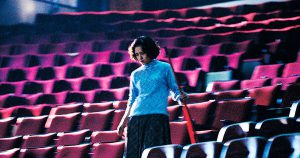
In her essay, Architects of time: Reel Images from Warhol To Tsai Ming-Liang, Italian scholar Giuliana Bruno tries to explore the connection of space and time in the post-modernism films. By examining several films from Andy Warhol and Tsai Ming-Liang, she regards these films as they “come to “architect” the very mood of inner life—a landscape of temps mort, a geology of passage. “and they also reveal one of the characteristics of the modernity, “A radical temporal refashioning of subjectivity”. Taking Warhol’s Empire (1964) as an example, she explains how the atmosphere reconstructs the architecture with the continuous interaction of light and time. Like other Warhol’s experimental films, reel time here passes at the same pace as the real time. However, these films are not simple reproduction of the reality, but a reflection. She also signifies these films’ long duration could bring the audience to a closer position to the films with more empathy. The temporal atmosphere is the core that relates to the internal space and feelings.
Based on Bruno’s argument, unlike the modernism films focusing on the effect of the time passage, the post-modernism films expand the temporal zones and try to discuss the very nature of time itself. Time feels like more spatial and solid within these Warhol-type films. In another film directed by Tsai Ming-Liang, Good Bye, Dragon Inn (2003), one single shot of the female character cleaning up the Fuhe Theatre after its last film screening before the demolishing continues for over three minutes. At this moment, the theatre on the screen forms an intertextuality with the theatre where audience are. Two time frames are inextricably working together as well as an intermediate space is formed between the architecture of two theatres. Thus the relevant everyday experiences of audience is awaken to empathize the despondent feeling of the character or even realize a self-loss status of themselves.
In the modern society, city itself has more and more close relationship with people’s daily life, the modern society’s expansion also brings about the alienation of modern people. Thus, there is no wonder that these films are also caring about the urbanscape and mourning for the decay of city’s historical buildings, which could also be the trigger of people’s personal living memory. As Abbas once stressed in Hong Kong: Culture and the politics of disappearance, people need to stay alerted about the way they observe the city in case “the delays of time and space are cancelled out by the speed of electronic media”. Though (physically) a shot could be as long as Warhol’s Empire, would the atmosphere still have the same impact on the audience if its origin is demolished and hardly traced back by the new generation? Or the intentions to creating these films are just a mental response to comfort the inane lonely modern urban people?
By Mi Lan (UID: 3035332294)
You have raised a very good reference of the Fuhe Theatre in Good Bye, Dragon Inn (2003) in comparison with Warhol’s Empire (1964), where the audience is forced to observe and reflect about their everyday lives and objects. I definitely agree that reel time should go beyond real time, however other than reflections of the past and current, how do you think the portrayal of the future plays out in the reel time?